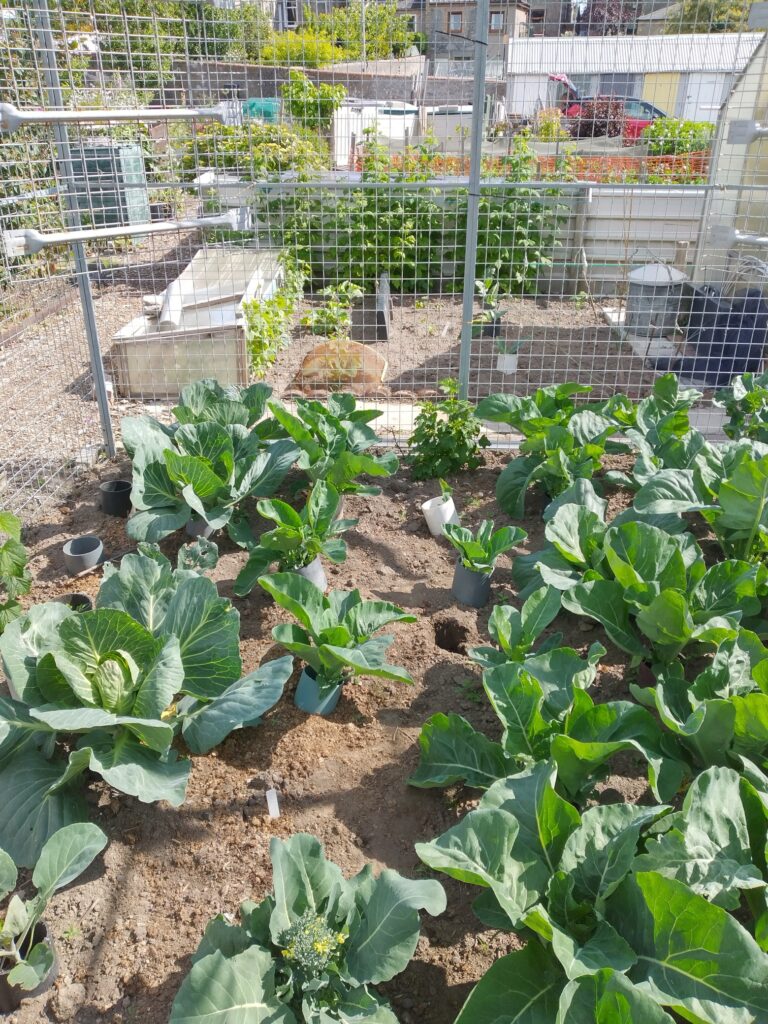Here are some tips and growing methods used by Neil

Background
It’s Neil’s second growing season on his plot, but he gained some experience on an introductory plot the previous year. Trial plots are increasingly being issued by allotment organisations to give people an idea of the work involved before committing. Neil uses a mix of dig and no-dig methods, with some of his no-dig areas in the ground, and others in raised beds.
Neil took over his plot from a grower who had cultivated phlox and dahlia for the past 35-40 years. So, while the site was quite tidy, Neil found the ground to be very compact in some areas. Other areas were covered in carpet which he soon pulled up as it isn’t allowed on the site.
Produce
Despite his limited time on the plot, it is already flourishing with a wide variety of food plants. Amongst the crops are potatoes, leeks, onion, garlic, beetroot, turnips, swedes, parsnips, spinach, peas, beans, herbs and a range of currants, berries and brassicas.
Soil and allotment maintenance
Neil appears to have learned a lot in a short space of time. This was through a mixture of research, experimentation and tapping into the knowledge of a number of highly experienced growers on the site. Some of his neighbours have had their plots for 40 years or more. After receiving contrasting advice on pruning blackcurrants from different growers (cut to ground or cut 2/3), he compared both methods and found them both successful. He’s also done his own experiments to compare planting seed onion and set onions, which ended up the same. This year he is trialling bought seed potatoes with those he kept from his last year’s crop.
Neil treats his soil according to the needs of specific crops. He uses high nitrogen fertiliser for brassicas, after liming their root zones while planting to deter clubroot. For his potatoes, he uses compost when planting and a balanced N, P, K fertiliser after finding they didn’t thrive without any. He also uses fish blood and bone, recommended by other growers, and a mix of shop bought and self-made compost.
Neil’s raised beds are deeper than average for the purpose being out of range of the carrot fly’s territory. The insects make carrots notoriously difficult to grow in the area, so when Neil heard that they don’t fly up more than 18 inches, he made sure his raised beds were higher. He still uses a fine mesh tunnel for extra protection. The potato patches are well dug, but Neil used minimal digging to clear left-over flowers and plant seeds. A neighbour recently informed him that crop rotations are more complex than not planting the same vegetable in the same place. He was advised that potatoes shouldn’t follow brassicas in a rotation as the lime applied to brassicas to prevent clubroot, can cause scabbing on the potatoes.
Tips for new growers in North East Scotland
Neil recommends a website with an adjustable calendar which automatically updates its recommended sowing and harvesting times according to your home town. The website Garden Focused can therefore be a useful resource for growers right across the UK, giving customised information for each area. Neil also uses an old, traditional allotment gardening book like a bible and advocates being social around the site to learn from other growers.
Other recommendations from Neil are to do some research into varieties and select ones which are recommended for the area, and don’t put everything in at once. Taking your time to think about it and staggering the sowing times can help prevent gluts. Also consider how easy the produce is to cook and eat, and how much of it you really want. After a successful crop of Jerusalem artichokes, Neil found them difficult to cook with but now can’t get rid of them, which he feels is a bit of a disaster.
Soil properties on Neil’s plot at Gray St

(Error bars show standard deviation from the mean.)

per litre of soil. (Error bars show standard deviation from the mean)

The measure mg/L (milligrams per litre) gives the same figures when converted to g/m3 (grams per meter cubed). Note that soil properties may be highly variable within a short distance and figures given are not representative of the whole allotment site. Indeed at this site, growers pointed out that upper parts of the hill are quite sandy, while those lower down have a high clay content.
Return to an overview of all the sites and people.